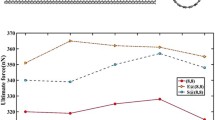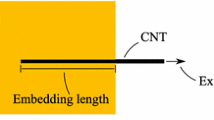Abstract
Carbon nanotubes (CNTs), including single-walled carbon nanotubes (SWNTs) and multi-walled carbon nanotubes (MWNTs), are considered to be the promising candidates for next-generation interconnects with excellent physical and chemical properties ranging from ultrahigh mechanical strength, to electrical properties, to thermal conductivity, to optical properties, etc. To further study the interfacial contact configurations of SWNT-based nanodevice with a 13.56-Å diameter, the corresponding simulations are carried out with the molecular dynamic method. The nanotube collapses dramatically into the surface with the complete collapse on the Au/Ag/graphite electrode surface and slight distortion on the Si/SiO2 substrate surface, respectively. The related dominant mechanism is studied and explained. Meanwhile, the interfacial contact configuration and behavior, depended on other factors, are also analyzed in this article.






Similar content being viewed by others
References
Ceyhan A, Naeemi A (2013) Cu interconnect limitations and opportunities for SWNT interconnects at the end of the roadmap. IEEE Trans Electron Devices 60:374–382
Close GF, Yasuda S, Paul B, Fujita S, Wong HSP (2008) A 1 GHz integrated circuit with carbon nanotube interconnects and silicon transistors. Nano Lett 8:706–709
Cui J, Yang L, Wang Y (2013a) Nanowelding configuration between carbon nanotubes in axial direction. Appl Surf Sci 264:713–717
Cui J, Yang L, Wang Y (2013b) Molecular dynamics study of the positioned single-walled carbon nanotubes with T-, X-, Y-junction during nanoscale soldering. Appl Surf Sci 284:392–396
Cui J, Yang L, Zhou L, Wang Y (2014) Nanoscale soldering of axially positioned single-walled carbon nanotubes: a molecular dynamics simulation study. ACS Appl Mater Interfaces 6:2044–2050
Cui J, Yang L, Wang Y, Mei X, Wang Y, Hou C (2015) Nanospot soldering polystyrene nanoparticles with an optical fiber probe laser irradiating a metallic AFM probe based on the near-field enhancement effect. ACS Appl Mater Interfaces 7:2294–2300
Cui J, Theogene B, Wang X, Mei X, Wang W, Wang K (2016a) Molecular dynamics study of nanojoining between axially positioned Ag nanowires. Appl Surf Sci 378:57–62
Cui J, Wang X, Theogene B, Mei X, Wang W, He X (2016b) Nanojoining of crossed Ag nanowires: a molecular dynamics study. J Nanopart Res 18:175
De Volder MFL, Tawfick SH, Baughman RH, John Hart A (2013) Carbon nanotubes: present and future commercial applications. Science 339:535–539
Do JW, Chang NN, Estrada D, Lian F, Cha H, Duan XJ, Haasch RT, Pop E, Girolami GS, Lyding JW (2015) Solution-mediated selective nanosoldering of carbon nanotube junctions for improved device performance. ACS Nano 9:4806–4813
Fuhrer MS, Nygård J, Shih L, Forero M, Yoon YG, Mazzoni MSC, Choi HJ, Ihm J, Louie SG, Zettl A, McEuen PL (2000) Crossed nanotube junctions. Science 288:494–497
Geier ML, McMorrow JJ, Xu W, Zhu J, Kim CH, Marks TJ, Hersam MC (2015) Solution-processed carbon nanotube thin-film complementary static random access memory. Nat Nanotechnol 10:944–948
Iijima S (1991) Helical microtubules of graphitic carbon. Nature 354:56–58
Jang I, Sinnott SB, Danailov D, Keblinski P (2004) Molecular dynamics simulation study of carbon nanotube welding under electron beam irradiation. Nano Lett 4:109–114
Krasheninnikov AV, Nordlund K, Keinonen J, Banhart F (2002) Ion-irradiation-induced welding of carbon nanotubes. Phys Rev B 66:245403
Laird EA, Kuemmeth F, Steele GA, Grove-Rasmussen K, Nygård J, Flensberg K, Kouwenhoven LP (2015) Quantum transport in carbon nanotubes. Rev Mod Phys 87:703–764
Ma M, Grey F, Shen L, Urbakh M, Wu S, Liu JZ, Liu Y, Zheng Q (2015) Water transport inside carbon nanotubes mediated by phonon-induced oscillating friction. Nat Nanotechnol 10:692–695
Malapanis A, Perebeinos V, Sinha DP, Comfort E, Lee JU (2013) Quantum efficiency and capture cross section of first and second excitonic transitions of single-walled carbon nanotubes measured through photoconductivity. Nano Lett 13:3531–3538
Manikandan E, Moodley MK, Ray SS, Panigrahi BK, Krishnan R, Padhy N, Nair KGM, Tyagi AK (2010) Zinc oxide epitaxial thin film deposited over carbon on various substrate by pulsed laser deposition technique. J Nanosci Nanotech 10:5602–5611
Motaung DE, Moodley MK, Manikandan E, Coville NJ (2010) In situ optical emission study on the role of C2 in the synthesis of single-walled carbon nanotubes. J Appl Phys 107:044308
Subash S, Kolar J, Chowdhury MH (2013) A new spatially rearranged bundle of mixed carbon nanotubes as VLSI interconnection. IEEE Trans Nanotechnol 12:3–12
Sun H (1994) Force field for computation of conformational energies, structures, and vibrational frequencies of aromatic polyesters. J Comput Chem 15:752–768
Terrones M, Banhart F, Grobert N, Charlier JC, Terrones H, Ajayan PM (2002) Molecular junctions by joining single-walled carbon nanotubes. Phys Rev Lett 89:075505
Thangavel S, Manikandan E, Venugopal G (2012) Synthesis and properties of tungsten oxide and reduced graphene oxide nanocomposites. Mater Exp 2:327–334
Yan K, Xue Q, Xia D, Chen H, Xie J, Dong M (2009) The core/shell composite nanowires produced by self-scrolling carbon nanotubes onto copper nanowires. ACS Nano 3:2235–2240
Acknowledgements
This project was supported by the National Natural Science Foundation of China (51505371, 11372264), Hong Kong Scholars Program (XJ2015038), China Postdoctoral Science Foundation (2014M562397, 2015T81018), a research grant from the Research Grants Council of the Hong Kong Special Administrative Region, China (CityU 114013), Program for Changjiang Scholars and Innovative Research Team in University (IRT_15R54), State Key Laboratory of Robotics and System (HIT) (SKLRS-2016-KF-13), and State Key Laboratory of Surface Physics and Department of Physics, Fudan University (KF2016_11).
Author information
Authors and Affiliations
Corresponding authors
Ethics declarations
Conflict of interest
The authors declare that they have no conflict of interest.
Rights and permissions
About this article
Cite this article
Cui, J., Zhang, J., He, X. et al. Investigating interfacial contact configuration and behavior of single-walled carbon nanotube-based nanodevice with atomistic simulations. J Nanopart Res 19, 110 (2017). https://doi.org/10.1007/s11051-017-3811-0
Received:
Accepted:
Published:
DOI: https://doi.org/10.1007/s11051-017-3811-0




